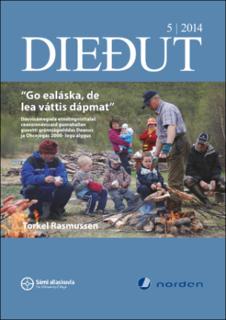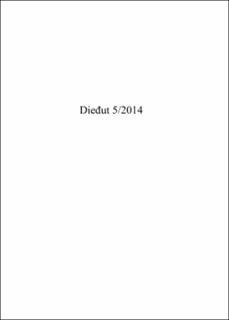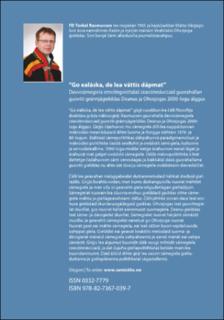| dc.contributor.author | Rasmussen, Torkel | |
| dc.date.accessioned | 2017-12-20T09:39:46Z | |
| dc.date.available | 2017-12-20T09:39:46Z | |
| dc.date.issued | 2014 | |
| dc.identifier.citation | Dieđut | nb_NO |
| dc.identifier.isbn | 978-82-7367-039-7 | |
| dc.identifier.issn | 0332-7779 | |
| dc.identifier.uri | http://hdl.handle.net/11250/2473199 | |
| dc.description.abstract | Dán giellasosiologalaš dutkamušas guorahalan davvisámegiela etnolingvisttalaš
ceavzinnávccaid guovtti gránnjágielddas; Deanus Norgga bealde ja Ohcejogas
Suoma bealde. Mákrodásis, mesodásis, sámi servodatdásis ja mikrodásis
dutkojuvvojit áššáigullevaš bealit mat ovttas hábmejit sámegiela ceavzinnávccaid
dán guovtti gielddas. Erenoamáš fuopmášumi bijan dasa, mo mákrodási
nuppástusat váikkuhit mikrodási sámegiela geavaheapmái sámegiela
ealáskahttináigodagas mii álggii 1990-logu álggus. Dutkamušas geavahan
dokumeantaanaliissa, jearahallanskovi, áiccademiid, áššejearahallamiid ja
kvalitatiiva dutkanjearahallamiid.
Dokumeantaanaliisa ja áššejearahallamat leat dehálamos metodat
mákrodási, sámi servodatdási ja mesodási dutkamis. Gažadanskovi lean
geavahan guorahallat 10–16-jahkásaččaid giellamáhtu, giellageavaheami,
gielalaš historjjá, gielalaš doaladumiid ja etnihkalaš identitehta. Dát dutkamuš
lea veahkadatguorahallan, mas leat fárus gaskacehkiid ja nuoraidcehkiid/
gaska- ja badjedási oahppit gávcci skuvllas Deanu ja Ohcejoga gielddas.
Oktiibuot 193 oahppi dahjege 71 proseantta gielddaid skuvllaid oahppiin
oassálastet dán veahkadatguorahallamii. Bohtosiid geavahan analyseret
sámegiela ceavzinnávccaid mesodásis ja mikrodásis. 12 bearraša leat fas
fárus kvalitatiiva dutkanjearahallamiin. Das guorahalan váhnemiid sámegiela
oččodeami, sámegiela lingvisttalaš oktavuođaid individuála fierpmádagaid ja
dáid fierpmádagaid rolla sámegiela sirdáseamis mánáide. Guovddáš gažaldat lea maid, mo váhnemat árvvoštallet sámegiela ceavzinnávccaid ja mo sin
mielas ođđa sámepolitihkka lea čađahuvvon ruovttugielddas.
Dutkamušas boahtá ovdan ahte sámegiela giellamolsun dárogillii ja
suomagillii lea dáhpáhuvvan dutkanguovllus, muhto giellamolsun lea
dál measta bisánan dan láhkai, ahte eanaš sámegielat váhnemat sámástit
mánáideasetguin. Sámegiela giellamolsuma jorgaleapmi dáhpáhuvvá maid
dan láhkai, ahte muhtimat giellamolsuma vásihan sápmelaččain leat oahppan
sámegiela ja/dahje sin mánát máhttet sámástit. Eanaš sámemánát eai
dattetge oahpa sámegiela nu bures ahte šaddet aktiiva hállin, jos ii leat
sámegielat váhnen guhte sámásta singuin ruovttus. Váhnemat geat ieža eai
sámás, vásihit ahte mánáidgárddit ja skuvllat eai nagat oahpahit sámegiela
sin mánáide. Váhnemat geat leat nagadan bajásgeassit mánáid sámegielagin,
atnet fas mánáidgárddiid, fulkkiid ja ustibiid nana doarjjan mánáid
sámegiela oččodeamis. Skuvllaid rollas mánáid sámegiela oččodeamis lea
gielddaidgaskasaš erohus. Deanu gieldda váhnemat atnet skuvlla dehálaš
sámegiela doarjjan. Ohcejoga gieldda váhnemat fas atnet skuvlla hehttehussan
mánáid sosialiseremis sámegielagin.
Dán dutkamuša analiissas boahtá ovdan ahte hehttehusat, maid váhnemat
vásihit, bohtet sihke mákrodásis ja mesodásis. Dáro- ja suomagielat
sámemánáin ii leat mákrodási láhkavuogádagas vuoigatvuohta oahppat
sámegiela beaktilis oahpahusmálle mielde dego giellabesiin ja vuođđoskuvlla
giellalávgunluohkáin. Mákrodássi addá vejolašvuođa dákkár beaktilis
oahpahusmálliide, muhto mesodási gielddat eai lágit oahpahusa mánáide
beaktilis oahpahusmálle mielde. Mákrodássi addá maid vejolašvuođa
ásahit sámegielat skuvllaid, muhto dákkár skuvlabálggis ii leat sámegielat
mánáid vuoigatvuohta. Deanu gielda lea dattetge válljen lágidit sámegielat
oahpahusa sierra sámegielat skuvllain. Ohcejoga gielda lea válljen lágidit
sámegielat oahpahusa sámegielat luohkáin suomagielat skuvllain. Dát
válljemat váikkuhit čielgasit mánáid ja nuoraid giellaválljemii ja joatkagis
mesodási válljemat váikkuhit dáid mánáid sámegiela máhttui.
Vai sámegiela ealáskahttin lihkostuvašii buorebut dutkanguovllus, de
dárbbašuvvojit nuppástusat sihke mákro- ja mesodásis. Mákrodássi sáhttá
mearridit ahte lea mánáid vuoigatvuohta beassat vázzit sámegielat skuvlla
ja oažžut sámegielat beaivedivššu ja oahpahusa beaktilis oahpahusmálle
mielde. Mesodási gielddat sáhttet dál juo dálá mákrodási rámmaid siskkobealde
rievdadit iežaset mánáidgárde- ja oahpahusvuogádagaid nu ahte
dat vástidivčče buorebut giellaealáskahttima dárbbuid. | nb_NO |
| dc.description.abstract | In this sociolinguistic dissertation I examine the ethno-linguistic vitality
of North Sámi in the two neighbouring municipalities of Deatnu/Tana in
Norway and Ohcejohka/Utsjoki in Finland.
Different factors on macro, meso, Sámi society and micro level together
shape the ethno-linguistic vitality of the Sámi language in these two municipalities.
The Sámi language revitalization era began throughout Sápmi
in the early 1990s but manifested differently in different areas. I argue this
is based on the larger socio-political conditions – thus the macro society
influences language on a micro level. My research focuses on how these
differences influenced local level revitalization processes. I utilized a variety
of qualitative research methods including: document analysis, participant
observation and interviews in addition to creating and analyzing questionnaires.
Although document analysis and case study analysis proved most
informative to locate larger socio-political trends, I used questionnaires
to focus on the actual practice of language and language revitalization.
Specifically the questionnaires solicited information on the ethnic identities,
linguistic history and language skills as well as actual language use of my
informants: children and youth age 10-16 years in the primary schools and
upper secondary schools in Deatnu/Tana and Ohcejohka/Utsjoki. All together
193 pupils or 71 percents of the pupils took part in the research. The results
of the questionnaires have been used to analyse the ethno-linguistic vitality
of Sámi language on meso and micro level.
I interviewed 12 families focusing on their roles in language revitalization.
The interviews focused on their process in learning Sámi language
and their network of linguistic contacts and specifically the role of these
networks in the transmitting of Sámi language to the children. The underlying
question in most of these interviews is how parents evaluate the vitality of
Sámi language and the role of the new Sámi policy in their home community.
One result of my research is that although there was a language shift
in the past away from Sámi to Norwegian and Finnish among some of the
Sámi people this language shift has nearly stopped because most of the
Sámi speakers now are speaking Sámi to their children. In fact one can
argue there is a reverse language shift occurring where some of the Sámis
that had lost their ancestors’ language as children have chosen to learn
Sámi as adults and are now speaking it with their own children. There are
even cases where the parents haven’t learned the language themselves but
encourage their children to do so thus ensuring the Sámi language is alive
and developing for the next generation.
The findings of my research indicate that children involved in the Sámi
language revitalization processes most often come from homes with at
least one, and sometimes two, Sámi speaking parents. Although formal
education in Sámi language is important so are larger extended linguistic
networks. For the parents that have raised their children as Sámi speakers,
kindergarten, extended family and friends are the most important supporters
for the language learning of the children.
When it comes to the role of the school, there is a clear difference between
the municipalities. The parents in Deatnu/Tana municipality consider the
school to play a significant role in the promotion of Sámi language. In
Ohcejohka/Utsjoki most of the parents consider the school as an obstacle
for the children’s socialisation as Sámi speakers.
In parents opinion the obstacles have roots both on the macro and
meso levels. Linguistically assimilated Sámi children lack legal rights to
learn Sámi language through strong forms of bilingual education such as
language nest or immersion classes in the formal school setting. Although
the state provides provisions for intensive language learning methods, the
municipalities don’t implement these possibilities for those children who
are not already speaking Sámi in the home. And although the state does
provide for the possibility of separate Sámi language schools these are also
implemented very differently in the two different municipalities. Deatnu/
Tana municipality organizes education in Sámi language for the Sámi
speakers in separate Sámi schools whereas Ohcejohka/Utsjoki municipality
organizes education with Sámi and Finnish as the languages of instruction
in the same Finnish schools. My data from questionnaires with children
and youths shows that these ways of organisation Sámi language education
influences clearly the use of Sámi language among children. The children
on the Finnish side use Sámi language considerably less than the children
on the Norwegian side. As a consequence of these meso level decisions,
the children on the Finnish side also feel that they master Sámi language
less fluently than the children on the Norwegian side.
In conclusion I argue there is a need for changes both on the macro
and meso levels in order to enhance revitalization of Sámi language in the
researched area. The macro level should decide that education in Sámi
language shall be given in separate Sámi language schools and furthermore,
Sámi children should have a legal right to get strong forms of bilingual
education in kindergarten and elementary school. And in addition, the
municipalities as the meso level should change their kindergarten and school
structure in order to better meet the requirements of the revitalization of
Sámi language. | nb_NO |
| dc.language.iso | smi | nb_NO |
| dc.publisher | Sámi allaskuvla | nb_NO |
| dc.relation.ispartofseries | Dieđut;5/2014 | |
| dc.subject | Språkbruk | nb_NO |
| dc.subject | Tana | nb_NO |
| dc.subject | Utsjok | nb_NO |
| dc.subject | Språk | nb_NO |
| dc.subject | Undervisning | nb_NO |
| dc.subject | Utsjoki | nb_NO |
| dc.subject | Revitalisering | nb_NO |
| dc.subject | Skole | nb_NO |
| dc.title | Go ealáska, de lea váttis dápmat | nb_NO |
| dc.title.alternative | Davvisámegiela etnolingvisttalaš ceavzinnávccaid guorahallan guovtti gránnjágielddas Deanus ja Ohcejogas 2000-logu álggus | nb_NO |
| dc.type | Book | nb_NO |
| dc.description.version | publishedVersion | nb_NO |
| dc.rights.holder | Sámi allaskuvla & Torkel Rasmussen | nb_NO |
| dc.subject.nsi | VDP::Social science: 200::Demography: 300 | nb_NO |
| dc.subject.nsi | VDP::Humanities: 000::Linguistics: 010 | nb_NO |
| dc.subject.nsi | VDP::Humanities: 000::Linguistics: 010::Sami language: 031 | nb_NO |
| dc.subject.nsi | VDP::Humanities: 000::Linguistics: 010::Finno-Ugric languages: 030 | nb_NO |
| dc.source.pagenumber | 342 | nb_NO |


